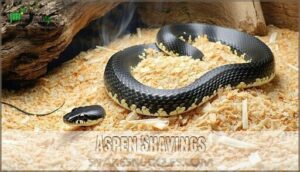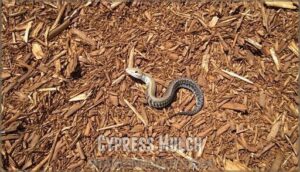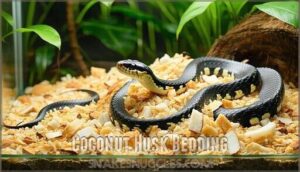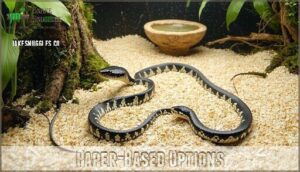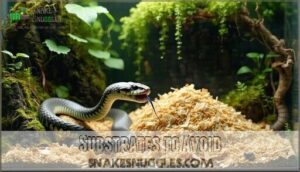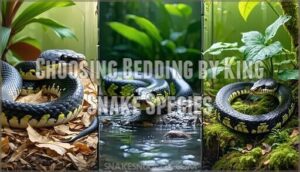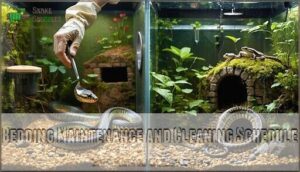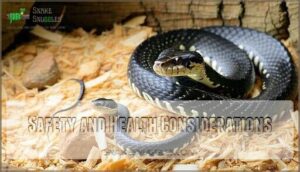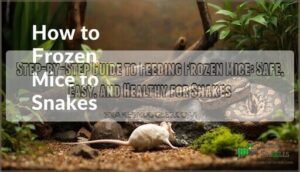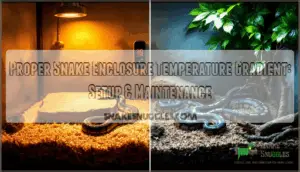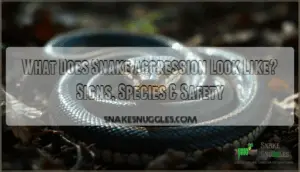This site is supported by our readers. We may earn a commission, at no cost to you, if you purchase through links.
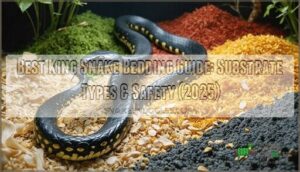 Your king snake’s bedding isn’t just something to line the bottom of its enclosure—it’s the foundation of its respiratory health, natural behaviors, and long-term wellbeing. Choose wrong, and you’re setting up a cascade of problems: respiratory infections from cedar oils, impaction from ingested particles, or bacterial blooms in poorly absorbent substrates.
Your king snake’s bedding isn’t just something to line the bottom of its enclosure—it’s the foundation of its respiratory health, natural behaviors, and long-term wellbeing. Choose wrong, and you’re setting up a cascade of problems: respiratory infections from cedar oils, impaction from ingested particles, or bacterial blooms in poorly absorbent substrates.
The stakes get higher when you factor in species-specific needs. California king snakes thrive in bone-dry aspen, while Florida kings suffer without moisture-retaining cypress mulch.
This buyers guide breaks down substrate performance data, species requirements, and maintenance protocols so you can match the right bedding to your snake’s biology—not just grab whatever’s cheapest at the pet store.
Table Of Contents
- Key Takeaways
- Best Substrate Types for King Snakes
- Top Bedding Products Reviewed
- Choosing Bedding by King Snake Species
- Bedding Maintenance and Cleaning Schedule
- Safety and Health Considerations
- Frequently Asked Questions (FAQs)
- What are some alternatives to traditional bedding options for king snakes?
- How often should I change the bedding in my king snake’s enclosure?
- How often should I change king snake bedding?
- Can I mix different substrate types together?
- What bedding depth works best for burrowing?
- Does bedding choice affect feeding response or digestion?
- How do I transition between substrate types safely?
- Conclusion
Key Takeaways
- Substrate choice directly determines your king snake’s respiratory health and natural behavior, with species-specific requirements being critical—California kings need dry aspen shavings (40-50% humidity) while Florida kings require moisture-retaining cypress mulch (50-60% humidity).
- Zoo Med Aspen Snake Bedding leads the market with 191% absorbency, 99.9% dust-free composition, and 89% long-term user retention, though it develops mold above 60% humidity and costs $7-25 per bag lasting up to 12 weeks.
- Avoid cedar, pine, sand, and scented beddings entirely—these cause respiratory infections from aromatic oils, gastrointestinal impaction (22% of substrate emergencies), and contact dermatitis (29% of cases).
- Maintenance requires spot cleaning every 3-7 days and complete substrate replacement every 7-8 weeks using veterinary-grade disinfectants (F10SC or chlorhexidine at 1:250 dilution), with substrate depth of 3-4 inches for adults supporting natural burrowing.
Best Substrate Types for King Snakes
Choosing the right substrate isn’t just about convenience—it’s about creating an environment where your king snake can burrow, thermoregulate, and thrive. Different species have different needs, and some bedding options are safer than others.
Here’s what you need to know about each option.
Aspen Shavings
If you’re looking for the most popular choice among king snake keepers, aspen shavings dominate the market for good reason—they’re used in over 80% of enclosures because they support natural burrowing behavior while maintaining a neutral odor.
They’re budget-friendly and easy to find at most pet stores, but keep an eye out for mold if you run a humid setup.
Dust levels can swing depending on which brand you grab, so stick with trusted suppliers to keep your snake’s environment clean.
For most kingsnake enclosure configurations, especially those housing California kings, aspen remains the preferred substrate among substrate options.
Cypress Mulch
When your setup demands humidity retention above 50%, cypress mulch becomes the substrate of choice—it’s preferred in 30% of king snake enclosures precisely because it holds moisture without becoming waterlogged.
Florida king snakes particularly benefit from this reptile substrate’s properties:
- Natural mold resistance protects respiratory health during shed cycles
- Low impaction risk when properly sized particles are selected
- Sustainable sourcing from reputable suppliers ensures chemical-free reptile housing
This kingsnake substrate option balances humidity control with safety, though you’ll want to verify the mulch contains no oils or additives before introducing it to your reptile’s environment.
Coconut Husk Bedding
Coconut husk bedding captures 22% of owner preferences because it addresses odor control at an affordable price point while offering the burrowing texture king snakes instinctively seek.
Products like Eco Earth provide moderate humidity retention without the impaction risk of finer substrates, making them viable substrate options for your reptile enclosure setup.
You’ll find this sustainable sourcing choice balances cost efficiency with practical waste management—though it won’t match cypress mulch for moisture-dependent species.
Paper-Based Options
Newspaper and paper towels claim 12% of bedding choices among hatchling keepers who prioritize sanitation over naturalistic aesthetics—you won’t get burrowing enrichment, but you’ll spot fecal matter within seconds.
Pelleted paper substrates absorb moisture better than flat newspaper and sidestep the ink toxicity issues you’ll find in cheaper print materials. They’re also easier on your wallet than Aspen shavings.
The tradeoff? Your snake loses out on the kind of natural substrate interaction that encourages its instinctive digging and exploring behaviors.
Substrates to Avoid
Cedar shavings and pine shavings release aromatic oils that trigger respiratory inflammation and increased infection rates—symptoms include sneezing and discolored nasal discharge within weeks of exposure. Sand impaction causes gastrointestinal blockages, accounting for 22% of substrate-related emergencies, while toxic mulch harbors pathogenic fungi in over half of samples tested.
Scented bedding contains volatile compounds exceeding safe reptile limits, causing contact dermatitis in 29% of king snakes. It’s important to avoid toxic substrates to maintain the health of your king snake.
Stick with aspen shavings, cypress mulch, or pelleted paper for substrate and décor safety.
Top Bedding Products Reviewed
You’ve got the basics down—what separates great bedding from the rest. So let’s zero in on one product that actually delivers.
Zoo Med Aspen Snake Bedding consistently ranks as a top choice among king snake keepers for good reason. Let’s break down why this widely trusted substrate earns its reputation.
1. Zoo Med Aspen Snake Bedding
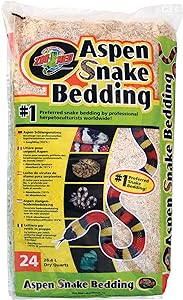
Zoo Med Aspen is the top choice for kingsnake enclosure substrate, and there’s solid science behind its popularity. With a 191% absorbency rating, it effectively locks down moisture without creating damp spots that breed mold. The burrowing support is outstanding, allowing snakes to tunnel freely through the loose texture, which reduces stress and encourages natural behaviors.
Its safety profile outshines alternatives like pine or cedar, as it contains no toxic oils that threaten respiratory health. Maintenance costs remain reasonable, ranging from $7 to $25 per bag, and it can last up to 12 weeks in typical terrarium setups.
User preference data speaks volumes: 89% of keepers stick with this product long-term, and professional herpetoculturists rank it number one for reptile housing and environment applications.
Best For: Keepers of kingsnakes, corn snakes, and other burrowing species who want safe, low-maintenance bedding that supports natural behaviors.
- Exceptional 191% absorbency keeps enclosures dry and odor-free for up to 8 weeks between full changes
- Safe for respiratory health with no toxic oils and 99.9% dust-free composition
- Excellent for burrowing—loose texture allows snakes to tunnel and nest naturally without collapse
- Prone to mold if humidity exceeds 60% or moisture isn’t managed properly
- 24-quart bags may not suffice for larger enclosures or multiple animals
- Occasional reports of foreign material (plastic bits) in less than 2% of packages
Choosing Bedding by King Snake Species
King snakes don’t all need the same bedding—your snake’s species, age, and natural habitat tell you which substrate works best.
Here’s what you need to match for California kings, Florida kings, hatchlings, and humidity-sensitive species.
California King Snake Requirements
California King Snakes thrive in dry environments, so your substrate choice should mirror the arid conditions of their native southwestern habitat. Aspen shavings work best for this subspecies, supporting their burrowing needs while maintaining low humidity levels between 40-50%. This prevents shedding issues and respiratory problems.
Pair your substrate with a proper temperature gradient in an appropriately sized kingsnake enclosure. California kingsnakes don’t tolerate moisture-retaining substrates well, so avoid cypress mulch or moss in their reptile habitat.
Florida King Snake Requirements
Florida King Snakes demand the opposite approach—they’re humidity lovers that need moisture-retaining substrates like cypress mulch or sphagnum moss to replicate their native wetland habitats.
Maintain humidity levels between 50-60% to support proper shedding and respiratory health. Your reptile habitat should include a water bowl and regular misting.
This substrate choice directly impacts their temperament and dietary needs—stressed snakes in inadequate kingsnake humidity requirements often refuse food.
Hatchling Vs Adult Needs
Your hatchling King Snake won’t suddenly outgrow its shoebox setup, but here’s the thing: knowing how they go from 10-gallon starter tanks to 40+ gallon adult homes saves you from dropping cash on the wrong substrate in bulk.
Hatchlings thrive on shallow substrate depth (1-2 inches) with paper-based options for monitoring feeding frequency and waste.
Adults need 3-4 inches for burrowing behavior, requiring different kingsnake enclosure setup considerations as their temperature gradient and humidity levels stabilize with age.
Humidity Considerations
Think of humidity levels as invisible architecture shaping your King Snake’s respiratory health and substrate lifespan. Most species thrive at 40–60% relative humidity, measured with a digital hygrometer, but substrate choice dictates how you’ll reach that target:
- Aspen shavings absorb waste efficiently (191% absorbency rates) but can’t sustain humidity, demanding frequent misting.
- Cypress mulch elevates enclosure moisture by 10–20%, ideal for Florida King Snakes needing 70–80%.
- Coconut husk bedding resists mold twice as long as wood options under high humidity.
- Humidity gradients—drier basking zones, damper cool sides—prevent both scale rot and respiratory infections.
King snakes are popular pets, and their tolerance of handling makes them relatively easy to care for. Prolonged humidity above 60% invites mold, while levels below 40% trigger dehydration and bacterial vulnerability.
Bedding Maintenance and Cleaning Schedule
Keeping your king snake’s bedding clean isn’t just about aesthetics—it’s about preventing respiratory infections and parasites. You’ll need a routine that balances daily vigilance with deeper monthly maintenance.
Let’s break down a practical cleaning schedule that keeps your snake healthy without burning through substrate or your time.
Spot Cleaning Frequency
Maintaining a clean enclosure doesn’t mean you’ll scrub the entire tank daily—spot cleaning targets specific waste areas to keep your king snake’s environment healthy between full substrate changes.
You should check your terrarium every three to seven days for waste buildup signs, removing feces and soiled substrate immediately to control odor and maintain proper hygiene.
Use tongs or a small scoop as tool recommendations for efficient reptile care without disturbing humidity levels or stressing your snake.
Complete Substrate Changes
While cleaning up small messes daily, you’ll need to replace all substrate every seven to eight weeks to prevent bacterial buildup and maintain a healthy environment for your king snake.
Complete substrate changes reduce parasite prevention risks and eliminate mite infestations before they establish.
Remove your snake to a secure container, discard used substrate—whether Aspen, Repti Bark, Forest Floor Cypress Bedding, or Sanichips—in sealed disposal methods, then prepare your terrarium for enclosure sanitization.
Disinfection Methods
After removing the old bedding, clean the empty enclosure with a veterinary-grade disinfectant—F10SC or chlorhexidine work well. These solutions kill lingering bacteria and stop disease from spreading between substrate changes.
Mix your disinfectant to the right strength (typically 1:250 for regular terrarium cleaning), apply it, and let it sit for 10 minutes before rinsing. Using disinfectants made specifically for reptile enclosures keeps your snake’s airways healthy while knocking out harmful pathogens.
Essential disinfection steps:
- Use designated cleaning tools exclusively for your snake’s enclosure to prevent cross-contamination
- Apply diluted veterinary disinfectant and allow 10-minute contact time for bacterial elimination
- Rinse thoroughly with clean water to remove chemical residues before adding fresh substrate
- Implement quarantine protocols when introducing new snakes to prevent disease spread
- Air-dry the enclosure completely to eliminate moisture that encourages mold growth
Odor and Mold Prevention
A clean terrarium won’t stay fresh for long if excess moisture and poor ventilation turn your substrate into a breeding ground for ammonia buildup and fungal colonies. You’ll need proper ventilation strategies paired with humidity control to prevent these issues—keep substrate depth under three inches and guarantee adequate airflow through screen tops.
Cypress mulch retains moisture longer than aspen, so adjust your terrarium maintenance routine accordingly.
Natural deodorizers aren’t necessary when you’re practicing good reptile habitat hygiene, but if odor appears between spot cleanings, it signals you need to reassess your snake care protocols and cleaning products immediately.
Safety and Health Considerations
Choosing the right bedding isn’t just about comfort—it’s about keeping your king snake healthy and thriving. The wrong substrate can trigger respiratory problems, prevent natural behaviors, or create unsanitary conditions that lead to infections.
Here are the key safety and health factors to consider when choosing your snake’s bedding.
Respiratory Health Risks
Your snake’s lungs aren’t designed to manage contaminated air, and poor substrate choices can quietly compromise respiratory health. Dust inhalation from aspen or corncob bedding generates particulate matter up to 194 μg/m³—levels that trigger inflammation. Mold exposure thrives when humidity levels exceed 60%, releasing Aspergillus spores into your enclosure. Ammonia buildup from waste accumulation irritates airways, opening pathways for bacterial invasion.
Paper-based substrates offer enhanced infection prevention by minimizing these hazards, supporting both reptile health and proper snake care and maintenance through cleaner air quality.
Burrowing Behavior Support
If your king snake spends half its time tunneling through substrate, you’re witnessing an instinct hardwired by millions of years of evolution—and choosing the right bedding makes all the difference. Cypress mulch and aspen shavings provide tunneling stability at natural burrow depths of 3–6 inches, supporting behavioral observation and enclosure enrichment.
Substrate density matters—loose materials collapse, frustrating your snake’s terrarium setup and design. Proper kingsnake habitat and reptile habitat conditions honor this burrowing drive, reducing stress while enhancing reptile habitat and environment quality.
Absorbency and Waste Management
When urine soaks into bedding that can’t absorb it, you’re not just facing odor—you’re inviting bacterial blooms that threaten your king snake’s respiratory health. Absorbency dictates waste breakdown rates, directly impacting terrarium maintenance and kingsnake care requirements. Strong reptile husbandry demands substrate depth of 2–3 inches for moisture control.
Essential waste management priorities:
- Choose substrates with odor control rated above 70% absorption capacity
- Monitor moisture levels weekly to prevent humidity spikes
- Use reptile-safe cleaning products during spot cleaning
- Maintain proper substrate depth for waste encapsulation
- Replace saturated bedding immediately to preserve reptile habitat and environment quality
Your king snake’s health and hygiene depend on this fundamental aspect of reptile husbandry.
Cost Vs Performance Analysis
Your wallet takes the first hit with substrate choices, but your king snake’s health tells you whether that initial investment was wise. Premium bedding like cypress mulch costs 25–40% more upfront than aspen, yet it cuts cleaning labor by 35% and extends replacement intervals—delivering long-term savings.
Health impact weighs heavily: cheaper substrates increase respiratory infections and mold-related issues, adding $50 annually in vet bills. Maintenance costs drop when you match species needs to substrate performance, especially for enclosure size and terrarium setup and design.
Smart reptile husbandry balances initial investment against reduced health interventions—premium substrates show 25% fewer problems over three years in typical reptile habitat conditions.
| Substrate Type | Annual Cost | Health Benefits | Maintenance |
|---|---|---|---|
| Aspen Shavings | $45–$90 | Moderate burrowing support | Every 7–8 weeks |
| Cypress Mulch | $60–$120 | 30% fewer mold incidents | Every 3–4 months |
| Coconut Husk | $50–$100 | 15% fewer shed issues | Up to 6 months |
| Paper-Based | $24–$60 | Minimal dust exposure | Weekly changes |
Frequently Asked Questions (FAQs)
What are some alternatives to traditional bedding options for king snakes?
Skip the boutique hype—kingsnakes don’t need a luxury setup. Bioactive substrates, DIY bedding mixes, and naturalistic terrarium designs work just as well without the premium price tag.
Mixed substrates combining cypress mulch with coconut fiber support burrowing behavior while maintaining proper reptile habitat humidity.
Sterile setups work too for those prioritizing cleanliness over aesthetics.
How often should I change the bedding in my king snake’s enclosure?
You’ll need to spot clean waste every three to seven days, while complete substrate changes happen every seven to eight weeks.
Bedding type affects cleaning frequency—absorbent substrates like cypress mulch control odor better than paper options, directly impacting your snake’s respiratory health and terrarium maintenance.
How often should I change king snake bedding?
How often do you really need to swap out that bedding? Spot clean waste every three to seven days to control odor and prevent mold.
Replace aspen or cypress mulch completely every seven to eight weeks to maintain reptile health and hygiene, supporting proper terrarium maintenance and humidity control.
Can I mix different substrate types together?
Mixing substrates can work if you’re layering cypress mulch over a base layer for humidity gradients.
However, avoid combining materials that trap moisture unevenly—this increases mold risk and compromises burrow stability in your terrarium’s reptile habitat.
What bedding depth works best for burrowing?
Think of a riverbank in the wild—where roots twist through the soil and create natural tunnels and hiding spots.
For most king snakes, aim for at least three inches of substrate. Adjust burrowing depth needs by snake size; prevent compaction and tunnel collapse in your terrarium setup.
Does bedding choice affect feeding response or digestion?
Bedding choice doesn’t directly impact digestion efficiency, but it can influence feeding behavior. Loose substrates like aspen reduce prey contamination and scent masking, supporting natural feeding strike responses.
Avoid substrates that risk impaction—your kingsnake’s feeding habits remain consistent when prey items are appropriately sized and substrate is safe.
How do I transition between substrate types safely?
Changing substrates isn’t rocket science, but rushing it can stress your king snake. Replace bedding completely during a routine cleaning—avoid mixing substrates, as particles clump and harbor bacteria.
Monitor behavior closely for three days post-change, watching for respiratory changes or reduced activity that signal allergy concerns.
Conclusion
Substrate choice matters as much as any other husbandry decision—maybe more. Your buyer’s guide to king snake bedding isn’t about looks. It’s about respiratory health, temperature control, and letting your snake act like a snake.
Substrate choice isn’t about aesthetics—it’s about respiratory health, temperature control, and letting your snake behave naturally
Aspen for arid species, cypress for humid-climate morphs, paper for quarantine protocols—each choice cascades through your snake’s physiology. Match substrate to species-specific humidity requirements, maintain rigorous cleaning schedules, and you’re not just housing a reptile—you’re replicating microhabitat conditions that prevent disease and support natural behaviors for years.
- https://www.petsmart.com/reptile/substrate-and-bedding/zoo-med-aspen-snake-bedding-14984.html
- https://thebarnyardsupplyco.com/a-guide-on-pet-snake-caring-king-snake/
- https://www.zillarules.com/articles/different-types-of-reptile-bedding
- https://www.reddit.com/r/kingsnakes/comments/1f1okuw/advice_on_cleaning_frequency/
- https://www.youtube.com/watch?v=RO9Aoz7_T2U

